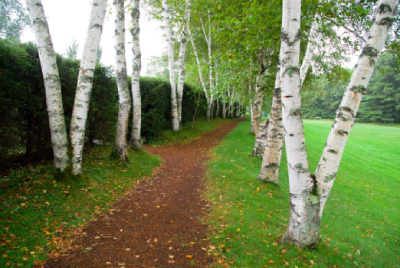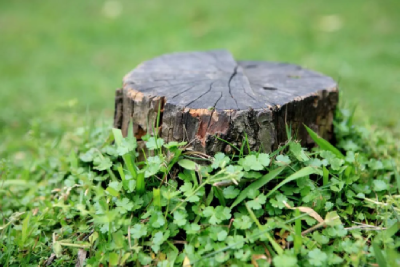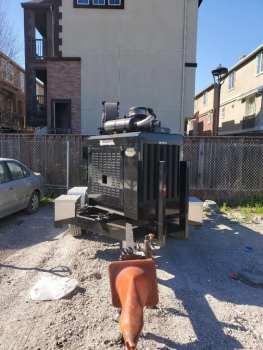

Timing is Everything: Timing plays a crucial role in the success of your pruning efforts. Aim to prune during the tree's dormant season, typically late fall or winter. This minimizes stress on the tree and reduces the risk of diseases or pest infestations. Avoid pruning during periods of active growth to ensure the tree can heal efficiently.
Use the Right Tools: Investing in high-quality pruning tools is a game-changer. Clean, sharp tools make precise cuts, promoting faster healing and reducing the risk of disease transmission. Ensure your toolkit includes pruning shears, loppers, a pruning saw, and, for larger branches, a pole pruner.
Prioritize Safety Measures: Safety should always be a top priority during tree pruning. Wear appropriate protective gear, including gloves, safety glasses, and a helmet if working at heights. Be mindful of your surroundings, and if the job requires climbing or heavy equipment, consider consulting a professional arborist.
Inspect for Diseases and Pests: Take the opportunity during pruning to inspect your tree for signs of diseases or pests. Remove any affected branches promptly to prevent the spread of issues. Early detection and intervention can save your tree from potential harm.
Armed with these tips, you're ready to embark on a journey of tree-pruning success. Remember, each cut you make contributes to the well-being and longevity of your leafy companions. Approach pruning with care, consideration, and a touch of finesse, and watch as your trees flourish under your attentive guidance.
Are your trees looking overgrown or tangled or posing safety risks? Without proper pruning, trees can become a liability, affecting their health and your property's safety. Overgrown branches can lead to hazardous limb failures, diminishing the visual appeal of your landscape. Neglecting tree pruning may weaken structures, making them susceptible to storms and disease. Discover the transformative benefits of tree pruning with our Comprehensive Guide. Take the first step towards healthier, safer trees. Contact us at (408) 712-4823 or visit https://www.ljrtreeservicesinc.com/ for expert pruning services. Your trees deserve the care they need!
Emergency Tree Removal: What You Need to Know - Assessing the Risks: Emergency Tree Removal Essentials
In arboriculture, the significance of prompt and decisive action in emergency tree removal cannot be overstated. While majestic and vital to our environment, trees can pose imminent threats under certain hazardous conditions. This blog highlights the critical importance of emergency tree removal, emphasizing the need for swift responses in safeguarding lives and property. As we delve into the intricacies of hazardous tree situations, we'll explore the signs, risks, and safety measures associated with such scenarios. Join us in unraveling the essential knowledge required to effectively address and mitigate potential tree-related dangers.
Hazardous Tree Removal: This blog discusses the importance of tree care for a safe outdoor environment but also highlights the risks of hazardous tree removal, the identification of hazardous trees, and the necessity of professional assessment and consultation.


Identifying Hazardous Trees: Recognizing signs of a hazardous tree is the first step in effective tree management. Visible indicators such as decaying branches, unusual lean, or fungus growth can signal potential danger. Regular tree inspections by certified arborists play a pivotal role in early detection, ensuring that necessary actions are taken promptly.
Risks Associated with Hazardous Trees: Hazardous trees pose various risks, including property damage and personal safety concerns. Falling limbs or the entire tree can damage buildings, vehicles, and other nearby structures. Additionally, the risk of injury to individuals within the vicinity is a serious consideration, especially during adverse weather conditions or storms.
Professional Assessment and Consultation: Addressing hazardous trees requires the expertise of certified arborists. These professionals possess the knowledge and experience to assess the condition of trees accurately, determine the level of risk, and recommend appropriate measures. Hiring certified arborists ensures the removal process is conducted safely, using the right equipment and techniques.
The Importance of Proper Equipment: Hazardous tree removal demands specialized equipment to ensure efficiency and safety. From cranes for tree removal in confined spaces to chainsaws for precise cutting, having the right tools is essential. Professional tree removal services invest in state-of-the-art equipment, prioritizing the safety of both their crew and the surrounding environment.
Hazardous tree removal is crucial for maintaining a secure outdoor space. Identifying warning signs, recognizing risks, and seeking professional assessment are essential. Prioritizing certified arborists and proper equipment can mitigate potential dangers, safeguarding property and personal well-being.
Deadwood Removal: Deadwood removal is crucial for tree health and safety, as it poses environmental risks and can compromise tree well-being. This blog discusses deadwood, its risks, benefits, and techniques for safety and aesthetics, highlighting the importance of proper removal.


Risks of Leaving Deadwood Unattended: Leaving deadwood unattended can result in several hazards. Dead branches are more susceptible to breakage and can fall unexpectedly, posing a threat to people, pets, and property below. In windy conditions or during storms, the risk of deadwood falling increases, making timely removal imperative for safety.
Techniques for Deadwood Removal: Deadwood removal involves careful pruning techniques to eliminate dead or dying branches. Proper pruning not only ensures the safety of the removal process but also contributes to the overall well-being of the tree. Techniques may include selective pruning, crown thinning, or canopy lifting, depending on the tree species and specific needs.
Pruning Practices: Pruning deadwood requires precision and expertise. Certified arborists use industry-approved pruning practices to remove deadwood without compromising the tree's structural integrity. This may involve making clean cuts near the branch collar to facilitate proper healing and minimize disease risk.
Safe Use of Chainsaws: Deadwood removal may involve using chainsaws for larger branches or trees. Safety is paramount during this process, and trained professionals take necessary precautions to protect themselves and the surrounding environment. Proper safety gear, careful planning, and adherence to industry standards ensure safe and effective deadwood removal.
Deadwood removal is vital to responsible tree care, contributing to safety and aesthetics. Understanding the risks associated with deadwood, recognizing its benefits, and employing proper removal techniques ensure that trees remain safe and thrive in their natural environment. By prioritizing deadwood removal, property owners can enhance their trees' health, beauty, and longevity while safeguarding their surroundings.
Lot Clearing: Beyond Aesthetics: Lot clearing, often associated with enhancing the visual appeal of a property, goes far beyond mere aesthetics. While creating a clean and well-maintained appearance is undoubtedly a benefit, the practice serves multiple purposes that extend into safety, environmental considerations, and legal obligations. In this blog, we delve into the various dimensions of lot clearing, exploring the reasons for undertaking this process, its associated challenges, and the importance of professional services in achieving a well-balanced and responsible approach.
